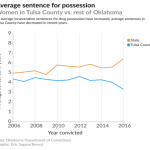Susan Sharp, a national expert on female incarceration and a professor emeritus at the University of Oklahoma, says women are collateral damage in the war on drugs. She wrote a book called, “Mean Lives, Mean Laws: Oklahoma’s Women Prisoners.” She took the name after having a conversation with a former colleague at the University of Oklahoma about the state’s prison system. She explained:
He very proudly showed me the women’s prison and then even more proudly told me that Oklahoma had the highest female incarceration rate. I asked him why he thought that was. He looked at me and he said, ‘Oklahoma has mean women.’ And after I picked my jaw off the floorboard of his car, I thought about not coming here. … Then I decided that maybe they needed me here.
Sharp’s research shows that poor women in rural areas receive longer sentences, while those who can afford private attorneys get less time for the same crimes:
There are some counties that are extremely harsh, that almost anyone convicted will go to prison. The district attorney is the most powerful player in the courtroom. … And if they are trying to build a reputation of being tough on crime, they’re basically going for the low-hanging fruit.
Joe Albaugh, the director of the state’s prison system, wants reform. Albaugh directed FEMA under George W. Bush, so he’s used to handling a crisis. Oklahoma’s ballooning prison population, however, is something else.
From his office on the campus of a minimum security prison in Oklahoma City, Albaugh tried to answer the question of why some of Oklahoma’s prison sentences are so long:
Judges say, ‘You know, you’ve been before me five times, Suzy Jones, and there won’t be a sixth time. I’m going to send you to prison so you can get some help.’ Practically, there is no help in prison. We are very limited in our programs, and there just is the belief that we ought to “lock them up, throw away the key.” And it doesn’t work.
Albaugh adds:
Ninety-four percent of our population returns to society. And what do we want? We want better neighbors. And the way we’re doing things and approaching things in our criminal justice system when it comes to prisons, we’re just a warehouse organization; that’s all we are. If we don’t do something different, our population with women will increase 57 percent over the next 10 years.
Kunzweiler says:
Everybody knows who that lawbreaker is. And so there is an expectation to, at some point, ‘get this person off my street because I’m tired of them breaking into my barn or breaking into my outbuildings.’ It’s hard to convince the community that you need to wrap your arms around the very person that you’re cognizant that is probably going to be going out stealing stuff.
A recent study by the Oklahoma Department of Mental Health and Substance Abuse Services shows that if mom goes to prison, there’s a good chance one of her kids will, as well. Susan Sharp knows about that domino effect.
“You can sometimes find … three generations of a family incarcerated at the same time. For example, a mother, a grandmother, the daughter,” she said.
The majority of women incarcerated in Oklahoma are doing time for nonviolent crimes and drug-related offenses. As Sharp explains, women, particularly mothers, are treated more harshly and sometimes receive longer sentences than men because their crimes are drug-related:
I think the general population of the state feels that a woman — particularly a woman who has children — who uses drugs, violates all the norms in a way that they find unacceptable and they would rather see those children grow up in foster care than to be with a mother who had a drug problem.
Sharp also explains that Oklahoma has outdated attitudes about what constitutes proper womanhood:
This is an extremely conservative state and an extremely religious state and very evangelical and a lot of biblical literalism. So, the belief that women have a certain role in society — that role is to give up themselves and put themselves and their own wants, goals, desires secondary to taking care of their husband and children.
According to the data, Native American women comprise 12 percent of Oklahoma’s prison population, while representing only 9 percent of the state’s population. Muscogee Creek Nation’s Reintegration Program is one way to ease the transition from prison to home. It’s funded by the tribe and helps ex-offenders get jobs, housing and rebuild their lives while supporting Native American culture. Tony Fish, the program manager, laid out the key reasons he thinks the program works:
I feel like, on our state side, we don’t hold the value in people like we do our tribal side, because that is part of our culture and who we are. We hold value in people, and we look at things through different lenses.
The program isn’t just for Native people. Fish explained they have resources for non-Indians, too. They visit prisons frequently, targeting inmates when they are about to go home.
At a recent graduation, Rona Stone spoke to a crowd of supporters and families. She spent nearly her entire life suffering from addiction, selling drugs and losing her teenage son to gang violence before she came to Women in Recovery.
“I have been trying for 27 years to fight this disease on my own, but I realized I just couldn’t do it. Women in Recovery saved my life,” Stone said.
If programs like Women in Recovery work so well, then why aren’t there more programs like it in the state? One of the biggest reasons is lack of funding. The program in Tulsa is funded by oil billionaire George Kaiser. The other reason is pushback from powerful prosecutors who don’t favor reducing sentences.
© Humane Exposures / Susan Madden Lankford










